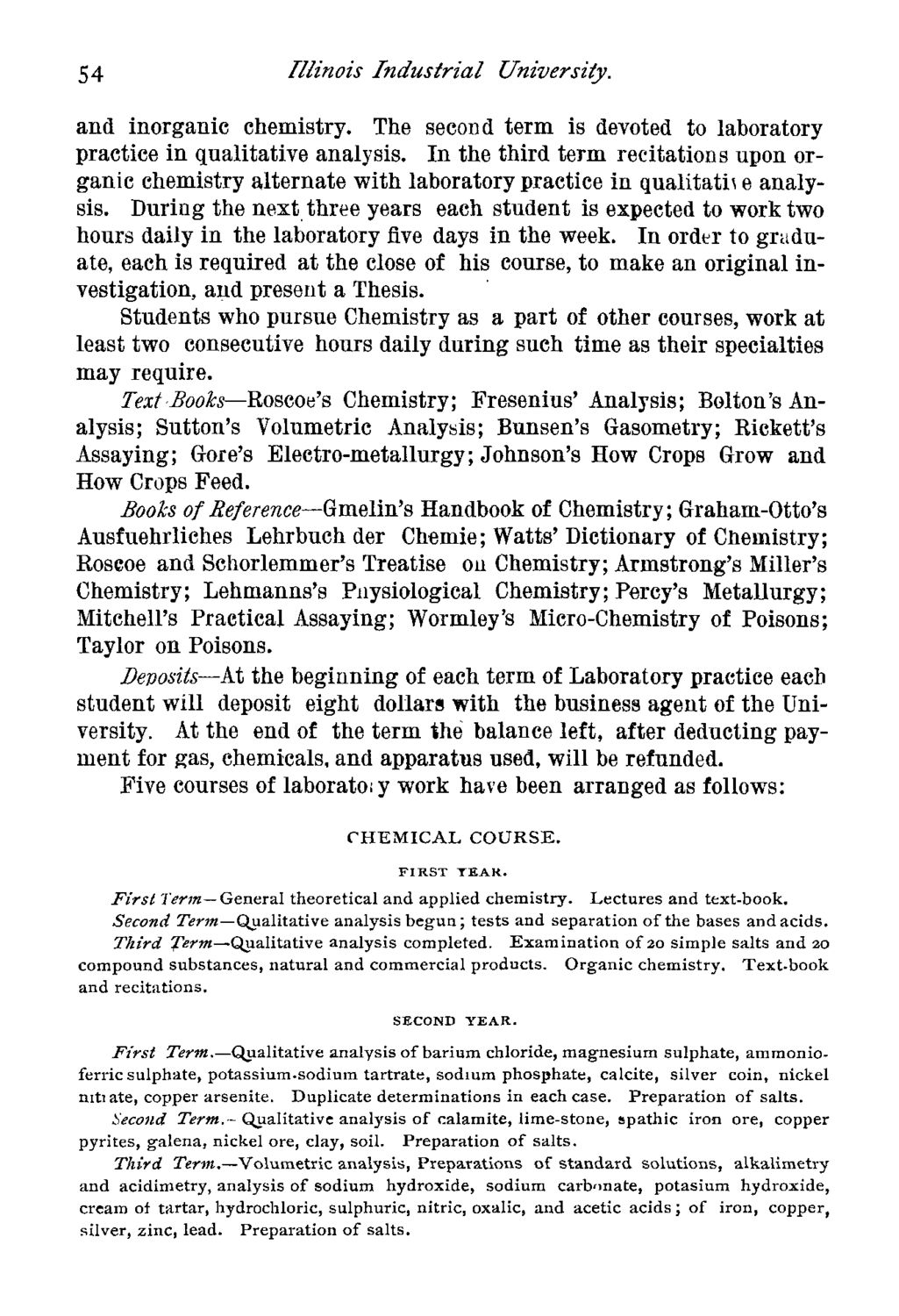| |
| |
Caption: Course Catalog - 1883-1884
This is a reduced-resolution page image for fast online browsing.

EXTRACTED TEXT FROM PAGE:
54 Illinois Industrial University. and inorganic chemistry. The second term is devoted to laboratory practice in qualitative analysis. In the third term recitations upon organic chemistry alternate with laboratory practice in qualitati\ e analysis. During the next three years each student is expected to work two hours daily in the laboratory five days in the week. In order to graduate, each is required at the close of his course, to make an original investigation, and present a Thesis. Students who pursue Chemistry as a part of other courses, work at least two consecutive hours daily during such time as their specialties may require. Text Boohs—Roscoe's Chemistry; Fresenius' Analysis; Bolton's Analysis; Sutton's Volumetric Analysis; Bunsen's Gasometry; Rickett's Assaying; Gore's Electro-metallurgy; Johnson's How Crops Grow and How Crops Feed. Boohs of Reference--Gmelin's Handbook of Chemistry; Graham-Otto's Ausfuehrliches Lehrbuch der Chemie; Watts' Dictionary of Chemistry; Roscoe and Schorlemmer's Treatise on Chemistry; Armstrong's Miller's Chemistry; Lehnianns's Pnysiological Chemistry; Percy's Metallurgy; Mitchell's Practical Assaying; Wormley's Micro-Chemistry of Poisons; Taylor on Poisons. Deposits—At the beginning of each term of Laboratory practice each student will deposit eight dollars with the business agent of the University. At the end of the term the balance left, after deducting payment for gas, chemicals, and apparatus used, will be refunded. Five courses of laboratoiy work have been arranged as follows: CHEMICAL COURSE. FIRST TEAK. First Term— General theoretical and applied chemistry. Lectures and text-book. Second Term—Qualitative analysis begun; tests and separation of the bases and acids. Third T^fws—Qualitative analysis completed. Examination of 20 simple salts and 20 compound substances, natural and commercial products. Organic chemistry. Text-book and recitations. SECOND YEAR. First Term.—Qualitative analysis of barium chloride, magnesium sulphate, ammonioferric sulphate, potassium.sodium tartrate, sodium phosphate, calcite, silver coin, nickel niti ate, copper arsenite. Duplicate determinations in each case. Preparation of salts. Second Term.- Qualitative analysis of calamite, lime-stone, spathic iron ore, copper pyrites, galena, nickel ore, clay, soil. Preparation of salts. Third Term.—Volumetric analysis, Preparations of standard solutions, alkalimetry and acidimetry, analysis of sodium hydroxide, sodium carbonate, potasium hydroxide, cream of tartar, hydrochloric, sulphuric, nitric, oxalic, and acetic acids; of iron, copper, silver, zinc, lead. Preparation of salts.
| |